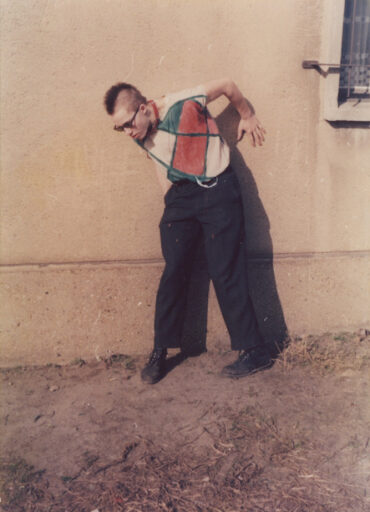
Berlin siebdruckt: Hubert Riedel und ZWÖLF

Hubert Riedel,Theatres du geste. Photos de Jean Pierre Gapihan, 1987, Siebdruck, Foto: Thomas Goethe © Hubert Riedel
Unter dem Kollektivnamen ZWÖLF fanden Stefan Guzy (geb. 1980) und Björn Wiede (geb. 1981), beide Absolventen der UdK Berlin, mehr und mehr ihr zentrales Signum im konzeptionell angelegten Typografie-Plakat für Kunden in den Bereichen Kunst, Musik und Kultur. Entwerfend wie eigenhändig am Drucktisch stehend, führen die beiden in einem Kreuzberger Hinterhof die über 100-jährige Drucktradition des Berliner Viertels im Gebiet des Siebdrucks fort. Experimente fernab materialtypischer Konventionen sind zu ihrer Domäne geworden: Serigrafien mit WC-Reiniger, Schaumbad, Öl, Honig, Nagellack, Lippenstift, Zahnpasta, Melasse und Knete auf Karton sowie mit Straßenkreide auf Bitumen belegen ihr starkes handwerkliches Interesse, das schließlich 2010 in die Gründung der Handsiebdruckerei Kreuzberg mündete. In den seit 2020 bestehenden „Handsiebdruckerei Editionen“ forcieren Wiede und Guzy diese Vorliebe für den künstlerischen Siebdruck, indem sie nun in Allianz mit ihren „favorite artists“ die Grenzen der Technik weiter ausloten.
Hubert Riedel (1948 Berlin-Friedrichshain – 2018 Berlin), der zunächst von 1965 bis 1974 als Fräser und Disponent im Schwermaschinen-bau arbeitete, gestaltete – autodidaktisch gebildet – von 1976 bis 1986 als Hausgrafiker sämtliche Drucksachen der Berliner Stadtbibliothek. Ab 1987 war er freischaffend tätig, hauptsächlich als Plakat-, Buch- und Ausstellungsgestalter. In Riedels gut 250 Blätter umfassendem Plakatwerk dominiert technisch der Siebdruck, wenn auch selten im Eigendruck. Sogar in seinen im Offsetdruck produzierten Plakaten ahmte er noch die ungebrochene Farbwirkung des Siebdrucks nach, indem er auf den vierfarbigen Rasterdruck verzichtete. In seinen vielmals bei den „100 besten Plakaten“ ausgezeichneten Siebdruckarbeiten kreierte er seinen unverwechselbaren, prägnant-sparsamen Stil, in dem er häufig dunkle Papieruntergründe mit Text-Bild-Kompositionen in leuchtenden Farben überzog.
Die Ausstellung Berlin siebdruckt: Hubert Riedel und ZWÖLF schöpft wesentlich aus den Beständen der eigenen Plakatkunst-Sammlung, die 2023 durch eine großzügige Schenkung von Hubert Riedel-Plakaten eine signifikante Erweiterung in diesem Fach erlebt hat.
…
The double exhibition combines posters from the completed work of the Berlin graphic artist Hubert Riedel with that of the Berlin graphic studio ZWÖLF, which was founded in 2000 and is still active today.
Under the collective name ZWÖLF, Stefan Guzy (born 1980) and Björn Wiede (born 1981), both graduates of the UdK Berlin, increasingly found their central Signum in conceptually designed typographic posters for customers in the areas of art, music and culture. Designing and standing at the printing table, the two of them continue the over 100-year-old printing tradition of the Berlin district in the area of screen printing in a Kreuzberg backyard. Experiments far removed from typical material conventions become their domain: serigraphs with toilet cleaner, bubble bath, oil, honey, nail polish, lipstick, toothpaste, molasses and modeling clay on cardboard as well as with street chalk on bitumen demonstrate their strong interest in craftsmanship, which ultimately resulted in the founding of the Kreuzberg hand screen printing factory in 2010. In the “Handscreen Printing Editions”, which have existed since 2020, they are pushing this preference for artistic screen printing, with Wiede and Guzy now further exploring the limits of the medium in alliance with their “favorite artists”.
Hubert Riedel, who initially worked as a milling cutter and dispatcher in heavy mechanical engineering from 1965 to 1974, designed all the necessary printed matter for the Berlin City Library from 1976 to 1986 as an in-house graphic artist – although he was self-taught. From 1987 he worked as a freelance graphic designer, mainly as a poster, book and exhibition designer. In his 250 poster works, screen printing dominates from a technical point of view, although rarely as his own prints. Even in his posters produced using offset printing, he imitated the unbroken color effect of screen printing by foregoing four-color screen printing. In his screen printing works, which have won numerous awards in the “100 Best Posters”, he created his unmistakable, concise, economical style, in which he often covered dark paper backgrounds with text-image compositions in bright colors.
The exhibition “Berlin siebdruck: Hubert Riedel und ZWÖLF” draws heavily from the holdings of the BLMKs own poster art collection, which experienced a significant expansion in this subject in 2023 through a generous donation of Hubert Riedel posters.











